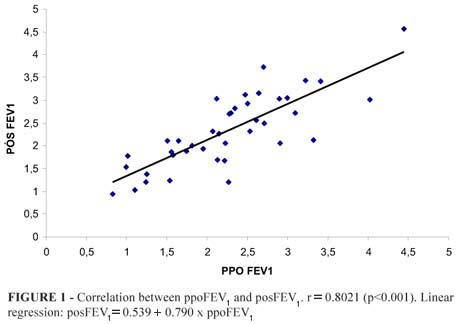PURPOSE: To assess whether the tests - Forced Expiratory Volume at one second (FEV1), 6-minute walk test (6MWT) and stair-climbing test (SCT) showed proportional changes after the resection of functioning lung. METHODS: Candidates for pulmonary resection were included. Spirometry, 6MWT and SCT were performed preoperatively (pre) and at least 3 months after surgery (pos). SCT was performed on a staircase with a total ascent height of 12.16m. The time taken to climb the total height the fastest possible was defined as stair-climbing time (SCt). Number of functioning segments lost, was used to calculated predicted postoperative (ppo) tests values. Pre, ppo and pos values for each test were compared. Data were analyzed by repeated-measure ANOVA with significance level set at 5%. RESULTS: A total of 40 patients were enrolled. Pulmonary resection results ranged from gain of 2 functioning segments to loss of 9. Pre, ppo and pos values were the following: preFEV1 = 2.6±0.8L, ppo FEV1 =2.3±0.8L, and pos FEV1=2.3±0.8L, (pre FEV1 > ppo FEV1 = pos FEV1); pre6MWT = 604±63m, ppo6MWT= 529±103m, pos6MWT= 599±74m (pre6MWT = pos6MWT > ppo6MWT); preSCt = 32.9±7.6s, ppoSCt = 37.8±12.1s, posSCt = 33.7±8.5s (preSCt = posSCt < ppoSCt). CONCLUSION: In our group of patients, pulmonary resection led to loss of lung function measured by spirometry, but not to exercise capacity measured by stair-climbing and walk tests.
Respiratory Function Tests; Heart Function Tests; Spirometry




